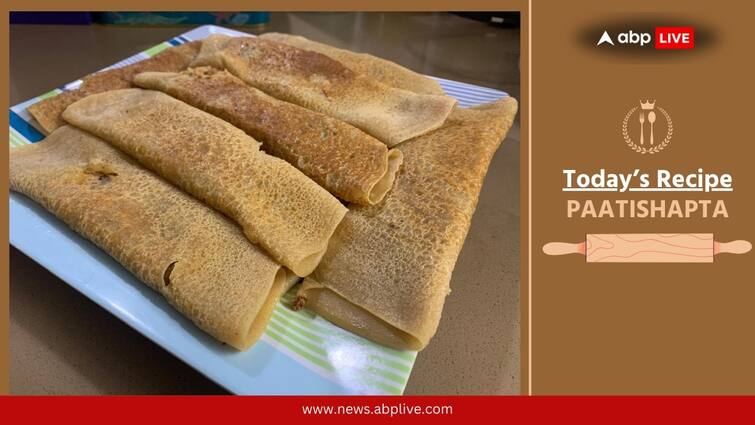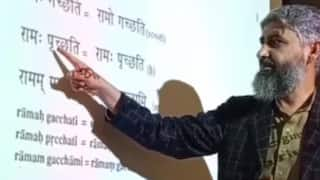Bengali Paatishapta Recipe: Make This Traditional Bengali Poush Sankranti Dish At Home
Makar Sankranti: Paatishapta is more than just a dessert; it’s a celebration of tradition, flavour, and festivity in every bite. Bengali households relish this 'pithe' on Poush Sankranti/Til Sankranti

Pancakes are often considered one of the oldest cereal-based foods in the world. Across cultures and continents, they take on various forms, flavours, and ingredients, but the essence remains the same — a delightful, versatile dish that brings people together. While some prefer their pancakes sweet and others savour them in a more savoury style, one thing is universal: they are always irresistible, satisfying, and utterly delightful.
Today, we are diving into the recipe for Paatishapta, a traditional Indian pancake hailing from the culturally rich state of West Bengal. This sweet treat is an integral part of Poush Sankranti, a harvest festival celebrated with joy and feasting. The festival, marking the end of the winter solstice, is incomplete without the aroma of freshly prepared paatishapta and other 'pithe' dishes wafting through Bengali households.
At its heart, paatishapta is a delightful combination of a thin, crepe-like pancake and a rich, sweet filling. The pancakes are made from a batter of rava (semolina), maida (all-purpose flour), and milk, resulting in a light and delicate texture. The traditional filling of grated coconut cooked in jaggery gives an earthy flavour that perfectly complements the pancake. Some replace the coconut filling with mawa (khoya) mixed with sugar, and dry fruits that add a luxurious and nutty sweetness.
For many Bengalis, paatishapta is more than just food — it’s a trip down memory lane. It’s often associated with childhood memories of gathering around a warm kitchen, watching mothers and grandmothers expertly flip the pancakes and stuff them with the heavenly filling. The dish carries with it the essence of family, love, and tradition.
Let’s explore this iconic dish that’s as steeped in history as it is in flavour. Here is the recipe for the mawa (khoya) version.
However, though deeply rooted in Bengali culture, paatishapta’s universal appeal lies in its simplicity and flavour. Its resemblance to crepes makes it relatable to global palates, while its sweet filling ensures it’s loved by anyone with a sweet tooth.
Whether you’re celebrating Poush Sankranti or just indulging in a sweet craving, paatishapta promises a delightful experience in every bite!
Ingredients
- 2 Cup Rava
- 1.5 Cup Maida/Aata (all-purpose flour)
- 5 Tablespoon Sugar
- 0.5 Teaspoon Baking soda
- 2 Cup Milk
- 0.5 Cup Ghee/Refined oil/Unsalted butter
- 2 Cup Khoya/Mawa
- 2 Tablespoon Raisins
Cooking Instructions
In a mixing bowl, combine 1 cup of rava (semolina) and 1 cup of maida (all-purpose flour).
Gradually add 2 cups of milk and 3 tablespoons of sugar, whisking until you achieve a smooth consistency.
Cover and let the batter rest for at least 2 hours.
Heat 1 cup of mawa (khoya) in a pan over low-medium heat.
Add 2 tablespoons of sugar and 1 cup of milk, stirring continuously.
Cook until the mixture thickens and dries up, forming a soft, crumbly texture.
Mix in 2 tablespoons of raisins.
Remove from heat and let the filling cool completely.
Before cooking, check the batter. If it feels thick, add more milk and mix until smooth and pourable for thin pancakes.
Heat a non-stick griddle or pan and lightly grease it with oil or ghee.
Pour a ladleful of batter onto the hot griddle and quickly spread it into a thin circle.
Cook on medium heat until the top sets and dries — do not flip the pancake.
Spoon a portion of the filling onto the centre of the cooked pancake.
Gently roll the pancake around the filling.
Repeat the process with the remaining batter and filling.
Serve the paatishapta warm for a comforting treat or chilled for a refreshing dessert. Enjoy!
Summary
Paatishapta Recipe: Make This Traditional Bengali Poush Sankranti Dish At Home
Makar Sankranti: Paatishapta is more than just a dessert; it’s a celebration of tradition, flavour, and festivity in every bite. Bengali households relish this 'pithe' on Poush Sankranti/Til Sankranti
Ingredients
- 2 Cup Rava
- 1.5 Cup Maida/Aata (all-purpose flour)
- 5 Tablespoon Sugar
- 0.5 Teaspoon Baking soda
- 2 Cup Milk
- 0.5 Cup Ghee/Refined oil/Unsalted butter
- 2 Cup Khoya/Mawa
- 2 Tablespoon Raisins
Main Procedure
In a mixing bowl, combine 1 cup of rava (semolina) and 1 cup of maida (all-purpose flour).
Gradually add 2 cups of milk and 3 tablespoons of sugar, whisking until you achieve a smooth consistency.
Cover and let the batter rest for at least 2 hours.
Heat 1 cup of mawa (khoya) in a pan over low-medium heat.
Add 2 tablespoons of sugar and 1 cup of milk, stirring continuously.
Cook until the mixture thickens and dries up, forming a soft, crumbly texture.
Mix in 2 tablespoons of raisins.
Remove from heat and let the filling cool completely.
Before cooking, check the batter. If it feels thick, add more milk and mix until smooth and pourable for thin pancakes.
Heat a non-stick griddle or pan and lightly grease it with oil or ghee.
Pour a ladleful of batter onto the hot griddle and quickly spread it into a thin circle.
Cook on medium heat until the top sets and dries — do not flip the pancake.
Spoon a portion of the filling onto the centre of the cooked pancake.
Gently roll the pancake around the filling.
Repeat the process with the remaining batter and filling.
Serve the paatishapta warm for a comforting treat or chilled for a refreshing dessert. Enjoy!


























